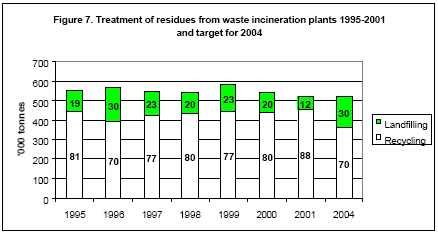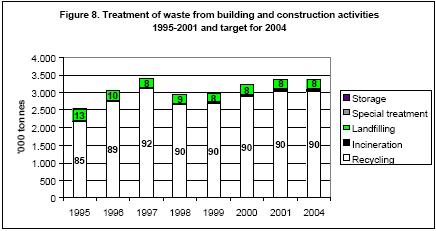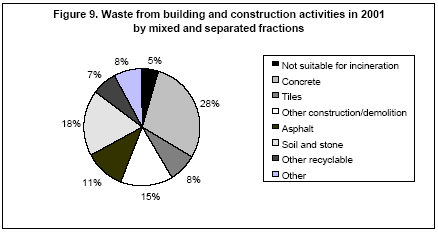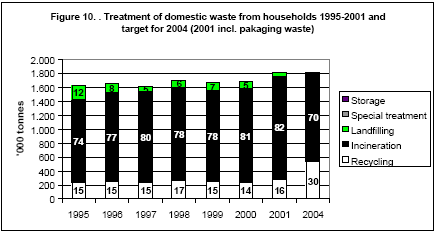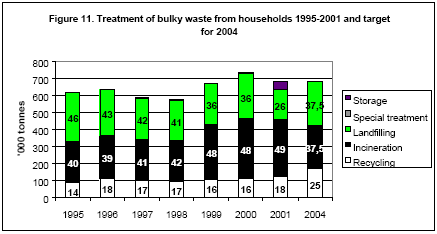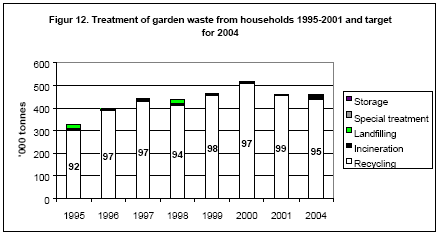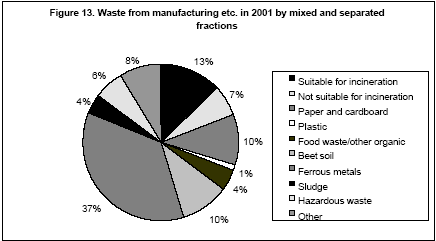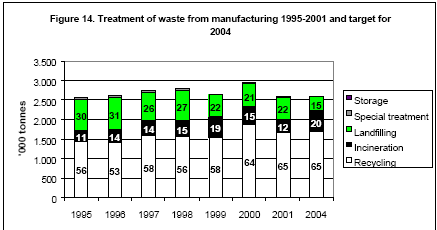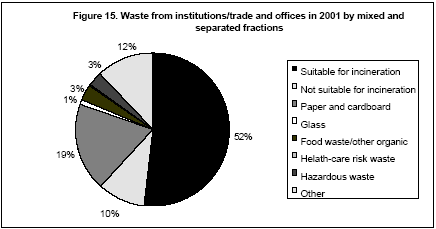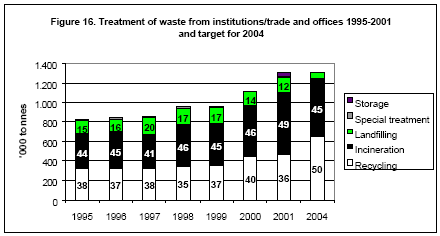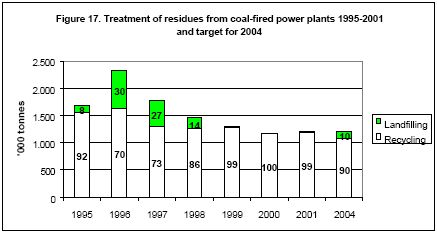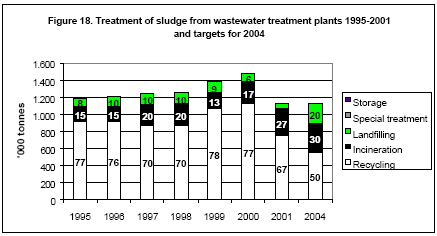|
Waste Statistics 2001 6 Waste sources and status compared to targets for 20046.1 Residues from waste incineration plantsFigure 7 shows amounts of residues (slag, fly ash, and flue-gas cleaning products) from waste incineration plants 1995 – 2001 in tonnes, including the treatment options used. Residues from waste incineration plants have not been included in calculations of total waste generation, since that would mean a double registration of the waste. However, residues are a large waste fraction and to secure adequate capacity for its treatment a calculation of amounts is required.
Source: See Tables 1 and 2. Note that arisings in 2004 have been set to correspond to arisings in 2001. The figure is not intended as a projection of developments in waste arisings for 2004. By far the largest part of residues is recycled – the rate of recycling was 88 per cent in 2001 which is 8 percentage points more than in 2000. Residues, however, are not recyclable when containing large quantities of heavy metals, which may leach into the environment and groundwater. In such cases landfilling of the residues is required. According to Waste 21, environmentally harmful waste fractions such as PVC, impregnated wood, waste electronic and electrical equipment must not be assigned to incineration in future. This means that contents of heavy metals in slag will be reduced significantly. However, recycling requirements will be made stricter out of consideration for groundwater. The target of a 70 per cent recycling rate in the previous action plan is therefore maintained in Waste 21. Table 14 shows further treatment of residues from waste incineration plants. Naturally, amounts of residues depend on the amount of waste that is incinerated. Slag and flue-gas cleaning products typically comprise around 20 per cent and 5 per cent, respectively, of waste amounts led to incineration.
Source: Calculations are based on ISAG reports and registrations under the EU regulation on shipment of waste. Note that Table 14 and Figure 7 are not comparable as Figure 7 does not include exports. Table 14 shows that residues from waste incineration amounted to around 539,000 tonnes in 2001 or 23,000 tonnes less than in 2000. Out of the 539,000 tonnes of residues that in total were removed from waste treatment plants, 203,000 tonnes were landfilled, and 406,000 tonnes were recycled. This means that stored amounts of fly ash and flue-gas cleaning products have been reduced by about 70,000 tonnes. From 1996 to 2001, amounts of landfilled residues have increased by 6 per cent and the rate of recycling has increased likewise by 6 per cent. 6.2 Waste from building and construction activitiesWaste from the building and construction sector amounted to 3,391,000 tonnes in 2001 - an increase of 168,000 tonnes or 5 per cent from 2000. By far the major part of waste from the building and construction sector is recycled. The distribution of waste on the different treatment options in 2001 remains unchanged from 2000; 90 per cent was recycled, whereas 2 per cent was incinerated and 8 per cent was led to landfill, cf. Figure 8.
Source: See Tables 1 and 2. Note that arisings in 2004 have been set to correspond to arisings in 2001. The figure is not intended as a projection of developments in waste arisings for 2004. As the figure shows, the recycling rate for construction and demolition waste has increased by 5 percentage points in the period from 1995 to 2001. At the same time the rate of waste for landfilling has dropped 5 percentage points. The figure also shows that the distribution of waste between the different treatment options has been in line with 2004 targets since 1997. The high recycling rate for construction and demolition waste is due partly to the fact that recycled waste, unlike landfilled or incinerated waste, is exempt from taxation, and partly due to a departmental circular on municipal regulation concerning the separation of construction and demolition waste intended for recycling [14]. In addition, the Danish Ministry of Environment and Energy (now Ministry of the Environment) and Danish Contractors' Association entered an agreement on selective demolition of building waste. However, waste treatment can still be improved. Therefore special efforts to separate and treat the most environmentally harmful waste types, such as PVC and impregnated wood, are needed in future. Finally, more use of a cradle-to-grave perspective and environmental planning in connection with new construction will be required. Figure 9 shows construction and demolition waste analysed between mixed and separately collected fractions in 2001. Most of the separately collected construction and demolition waste consists of concrete, other construction and demolition waste, and soil and stone.
Source: ISAG reports 2001. Note that the key to the diagram starts with "not suitable for incineration" shown as 5 % in figure, and should be read clockwise. The increase in total amounts of construction and demolition waste is due to an increase in the fractions "tiles", "other construction and demolition waste", and "soil and stone", which have increased by 30 per cent, 78 per cent and 26 per cent respectively compared to 2000. The increase in amounts of other construction/demolition waste can be explained partly by reductions in remaining fractions. One might suspect that less care has been taken in allocating the waste on specific separately collected fractions during the 2001 registration. Most waste from the building and construction sector is reprocessed at mobile crushing plants that are used for different assignments at shifting locations throughout Denmark. The owner of the mobile crushing plant is responsible for the ISAG reports to the Danish EPA, but sometimes the contractor also registers the waste. The Danish EPA is very much aware of this potential source of double registration and great efforts are made - in cooperation with the providers of the reports - to ensure quality control and avoid double registration. 6.3 Waste generated by householdsWaste from households covers the waste types domestic waste, bulky waste, and garden waste, which in turn are divided into individual fractions, e.g. paper and cardboard, bottles and glass, and food waste/other organic waste. Table 15 shows waste arisings by mixed and separately collected fractions to the extent these have been individually registered. This means that the stated amounts of e.g. paper and cardboard do not show the potential total amounts of paper and cardboard in household waste generation, but only the amounts of waste that have been separated and collected for recycling. The rest of the paper is part of the fraction "various suitable for incineration". Waste arisings in households in 2001 amounted to 3,082,507 tonnes, which means the figure is unchanged from 2000. Domestic waste amounts also remain virtually unchanged from the previous year - showing only a slight increase of 25,000 tonnes. The reductions in total household waste arisings are therefore to be found in amounts of bulky waste and garden waste, which have fallen by 7 per cent and 12 per cent respectively. Domestic waste, however, still makes up the largest part of total household waste generation, namely 55 per cent.
Source: ISAG reports. (1) For the year 1996, ferrous metals are included under "Other". Table 15 shows several changes among the different household waste fractions, so that paper and cardboard, bottles and glass, and ferrous metals have increased by 6 per cent, 38 per cent, and 41 per cent respectively compared to waste arisings in 2000. These increases are balanced by decreases in the fractions garden waste and hazardous waste, which have fallen by 10 per cent and 54 per cent respectively compared to the previous year. 6.3.1 Household waste per capita and per householdIn Table 16 household waste generation is stated per capita and per household. Amounts are moreover analysed between selected waste types and separately collected waste fractions. Total household waste generation stated per capita amounted to 567 kg in 2001, which is 11 kg less than in 2000. Stated per household, waste production amounted to 1261 kg in 2001, which is 33 kg less than in 2000. Domestic waste amounts per capita and per household were 318 kg and 696 kg respectively in 2001. Compared to 2000, this means a slight increase of 4 kg per capita, while the amount per household has decreased by 7 kg.
Source: ISAG reports. Statistics Denmark figures on population growth and number of households have been used. Note that Table 15 and 16 are not directly comparable, as Table 15 concerns waste production analysed by fractions while Table 16 also includes waste types. 6.3.2 Domestic wasteDomestic waste generated by households covers ordinary waste from private household consumption. This includes paper, bottles, glass, organic food waste, and other waste. Usually, domestic waste is collected from households at regular intervals once a week or once every other week. As mentioned above, domestic waste amounted to 1,701,000 tonnes in 2001, which is 25,000 tonnes more than in 2000. Since 1995, domestic waste arisings have varied slightly from year to year without showing any clear trend. Throughout the whole period from 1995 to 2000, arisings have been stable, cf. Table 1. In 2001, 16 per cent of domestic waste was recycled, while 82 per cent was incinerated and 3 per cent landfilled. Compared to 2000, this means a 2 per cent decrease in amounts led to landfill, which is balanced by a 2 per cent increase of the recycling rate. For the years before 2001, packaging waste is included as part of the waste type domestic waste. To make comparison with previous years possible, the 107,000 tonnes of packaging waste have been included in the calculations in Figure 10. As the table shows, the relative distribution in the period 1995 to 2001 among treatment options has varied slightly. If considering the whole period, the trend since 1996 has shown that around 80 per cent of domestic waste is incinerated, while 15 per cent is recycled and 5 per cent led to landfill. Thus, compared to Waste 21 targets, there is still too much waste being incinerated and landfilled. Note that assigning organic domestic waste to incineration is mandatory. However, for islands that do not have a land connection to the mainland there is an exemption from this obligation.
Source: Same as Tables 1 and 2. Note that arisings in 2004 have been set to correspond to arisings in 2001. The figure is not intended as a projection of developments in waste arisings for 2004. 6.3.3 Bulky wasteBulky waste generated by Danish households amounted to 680,000 tonnes in 2001. This is 50,000 tonnes less than in 2000 or a 7 per cent decrease in amounts. During the period from 1995 to 2001 bulky waste arisings increased by 10 per cent. The general increase was interrupted only by minor reductions in the 1997 and 1998 amounts, cf. Table 1. The general increase in amounts of bulky waste is partly due to a real increase in arisings, but the establishment of waste-collection and waste-delivery schemes also plays a significant role. Figure 11 shows the distribution of bulky waste arisings on the three treatment options: landfilling, incineration, and recycling for the period 1995-2001. The period 1995 – 1998 shows an almost unchanged distribution on treatment options: incineration around 40 per cent, landfilling around 43 per cent, and recycling around 17 per cent. The rate of bulky waste for incineration rose to 48 per cent in 1999 and 2000, while the rate of waste for landfilling fell to 36 per cent. In 2001, 49 per cent of bulky waste was incinerated; the rate for landfilling fell to 26 per cent, and the rate for recycling rose to 18 per cent. The remaining 6 per cent of bulky waste is stored temporarily until incineration capacity becomes available [15]. This means that the real rate of bulky waste for incineration is higher than 49 per cent. The target of a maximum landfilling rate of 37, 5 per cent has thus been reached. However, still too much bulky waste is being incinerated and not enough is being recycled. If targets for treatment in 2004 are to be reached, considerable efforts are required to individually separate and collect more of the different waste fractions in bulky waste. A number of initiatives covering e.g. cardboard, waste electronic and electrical equipment, impregnated wood and PVC-containing materials have or are in the process of being implemented.
Source: Same as Tables 1 and 2 Note that arisings in 2004 have been set to correspond to arisings in 2001. The figure is not intended as a projection of developments in waste arisings for 2004. 6.3.4 Garden wasteGarden waste collected from households in 2001 amounted to 458,000 tonnes, which is 61,000 tonnes less than in 2000, corresponding to a fall of 12 per cent. Throughout the 1990s garden waste arisings have increased steadily. During the period from 1995 to 2000 there was an increase of 59 per cent. This increase should not so much be understood as a real increase in garden waste amounts; rather it is the result of increasing opportunities for householders to dispose of garden waste at municipal treatment plants at the expense of home-composting of waste. This leads to larger amounts of waste that need to be treated in the municipal system. Garden waste treatment is presented in Figure 12. In 2001, 99 per cent of garden waste was recycled, and 1 per cent was led to landfill. Thereby, targets for recycling and incineration of garden waste from households have been met with a good margin. Estimates indicate that it is impossible to further increase the recycling rate. Therefore, future efforts with respect to garden waste will concentrate on maintaining the present high recycling rate and to reduce amounts treated in the municipal waste management system.
Source: Same as Tables 1 and 2 Note that arisings in 2004 have been set to correspond to arisings in 2001. The figure is not intended as a projection of developments in waste arisings for 2004. 6.4 Waste from manufacturing industriesWaste generation from industry amounted to 2,616,000 tonnes in 2001, which is 332,000 tonnes or 11 per cent less than in 2000. The distribution of waste from industry on mixed and separated fractions is shown in Figure 13. It is seen that "ferrous metals" by far is the largest single fraction followed by the mixed fraction "waste suitable for incineration", separated "paper and cardboard", and "beet soil". The relative distribution of total industrial waste on the different fractions remained almost unchanged in 2001 compared to 2000. However, as mentioned above there has been a decrease in amounts of industrial waste of around 332,000 tonnes. The fall is primarily due to reductions in the fractions: waste suitable for incineration, waste not suitable for incineration, paper and cardboard, food waste/other organic waste, and ferrous metals. These fractions were reduced by 29 per cent, 35 per cent, 7 per cent, 33 per cent, and 19 per cent respectively.
Source: ISAG reports 2001. Note that the key to the diagram starts with "suitable for incineration" shown as 13 % in figure, and should be read clockwise. By contrast, the fractions "beet soil", "sludge", "hazardous waste", and "other" have shown an increase of 16 per cent, 24 per cent, 90 per cent, and 38 per cent respectively. The increase of 90 per cent for hazardous waste is due to changes in the ISAG calculation methods. Shredder waste has been registered as hazardous waste in 2001, whereas previously shredder waste was reported as part of the non-hazardous fraction "various unburnable". Shredder waste amounted to 92,101 tonnes in 2001. This indicates that in 2001 there has been less separation of recyclable waste such as paper and cardboard, food waste/other organic waste, and ferrous metals, as compared to the previous year. The treatment of waste from industry is shown in Figure 14. In 2001, 65 per cent of the waste was recycled. In absolute figures, this means 1,688,000 tonnes were recycled in 2001 compared to 1,896,000 tonnes in 2000 - corresponding to a fall of 208,000 tonnes. The rate of industrial waste incinerated in 2001 reached 12 per cent, which is 3 percentage points less than in 2000. The rate led to landfill remained almost unchanged from 2000 at 22 per cent. This means that the target of landfilling a maximum of 15 per cent of industrial waste has not been met. Still far too much of waste from industry is landfilled. Even if the rates of recycling and landfilling have taken a positive direction since 1995, there is still some way to go before the targets for these two treatment options have been met. Amounts and composition of waste from manufacturing industries depend on the sector generating the waste, as well as size and number of enterprises. Possibilities of minimising or recycling waste will therefore differ from one waste fraction and sector to another.
Source: Same as Tables 1 and 2. Note that arisings in 2004 have been set to correspond to arisings in 2001. The figure is not intended as a projection of developments in waste arisings for 2004 In order to meet targets in Waste 21, the Danish EPA has selected a number of waste types from industry for special attention. One such waste type is shredder waste. New treatment technologies will contribute to diverting shredder waste from landfilling to recycling. Another waste type in focus is hazardous waste, for which collection schemes will be established with a view to separation and recycling. Through the latest amendment to the Statutory Order on Waste, The Danish EPA has implemented a number of changes to the ISAG system so that from year 2001 it will be possible to state figures for waste from industry in eleven different sectors. In future a number of enterprises [16] must in addition keep a register in a specific format with various information on their waste generation. This will enhance the possibility of conducting sector-specific analyses and initiatives in industry. Waste generation in industry stated by sector and treatment option can be seen in Table 17. As the table shows, almost 35 per cent of industry waste arisings in 2001 has been reported with the discontinued source "manufacturing industries etc." This is because a number of reporting plants, due to technical reasons, continued registering waste according to the provisions of the old Statutory Order during part of 2001. The 2001 figures are therefore only indicative of the distribution of waste between the different sectors.
Source: ISAG reports 2001. The Table does not cover beet soil and ferrous metals reported by large scrap dealers. Note that amounts have been rounded to the nearest hundred. "Manufacturing industries etc." covers amounts that for technical reasons have been reported according to provisions in the old Statutory Order. 6.5 Waste from institutions, trade and officesWaste generated by the service sector [17] amounted to 1,307,000 tonnes in 2001, which is 188,000 tonnes or 17 per cent more than in 2000.
Source: ISAG reports 2001. Note that the key to the diagram starts with "suitable for incineration" shown as 52 % in figure, and should be read clockwise. Waste from the service sector analysed between mixed and separated fractions is shown in Figure 15. The relative distribution is almost the same in 2001 as in 2000. "Waste suitable for incineration" and "paper and cardboard" are the two largest waste fractions generated by institutions, trade and offices, making up respectively 52 per cent and 19 per cent of waste from this source. The increase in waste arisings from the service sector in 2001 is noticeable in all fractions. However, the increase is most significant in the following fractions: waste not suitable for incineration, paper and cardboard, food waste/other organic waste, health-care risk waste, and hazardous waste. These fractions increased by 54 per cent, 8 per cent, 25 per cent, 40 per cent, and 29 per cent respectively compared to 2000. Glass is the only fraction showing a fall. The decrease is equivalent to 38 per cent less glass being separated by the service sector. The fall can be explained partly by the changes in the registration of bottles and glass from recycling centres/transfer stations, meaning that around 37,500 tonnes of glass have been moved from the service sector to households. Of the 1,307,000 tonnes of waste generated by the service sector in 2001, 36 per cent was recycled and 49 per cent was incinerated, whereas 12 per cent was led to landfill and 3 per cent was stored temporarily, cf. Figure 16. The rate of service sector waste led to incineration has increased by 3 per cent compared to 2000 and 3 per cent is in temporary storage until incineration capacity becomes available [18]. Thus the rate of waste for incineration is actually higher than the 49 per cent mentioned above. Compared to the previous year, the recycling and landfilling rates have fallen by 4 per cent and 2 per cent respectively. This means that there has been a diversion from landfilling and recycling to incineration. Compared to the 2004 targets for treatment in Waste 21, still too little waste from the service sector was recycled and too much landfilled in 2001. If targets are to be met, separation and collection of waste must be improved so that a larger proportion of recyclable materials can be recycled and so that environmental contaminants can be separated and treated separately.
Source: Same as Tables 1 and 2. Note that arisings in 2004 have been set to correspond to arisings in 2001. The figure is not intended as a projection of developments in waste arisings for 2004. 6.6 Residues from coal-fired power plantsThe generation of residues at coal-fired power plants varies from one year to the next due to variations in Danish imports/exports of electricity to and from Sweden and Norway. Imports/exports of electricity to and from Sweden and Norway depend largely on precipitation in these countries – if there is much precipitation much electricity is generated from hydropower in Sweden and Norway, and Danish exports will be correspondingly lower. For example, in 1996 exports of electricity were particularly high, which is reflected in amounts of residues in that year, cf. Figure 17. In 2000, there was much precipitation in Sweden which resulted in so much cheap hydroelectricity on the market that power plants in both Denmark and Norway had to cease operations temporarily. Amounts of residues have decreased steadily since 1996. This decrease is explained partly by less power exports in the years since 1996, and partly by the Danish Government's Energy Action Plan, "Energy 21", according to which natural gas and renewable energy sources, including bio-fuels, shall substitute coal in the long-term perspective. Energy statistics [19] show that a decreasing part of electricity generation is based on coal. Also in future, Energy 21 will result in a decrease in residues from coal-based energy generation, whereas there will be an increase in fly ash and bottom ash from bio-fuels. Residues from coal-fired power plants amounted to around 1,211,000 tonnes in 2001, which is an increase of 3 per cent from 2000. As Figure 17 shows, 99 per cent of residues was recycled and 1 per cent was landfilled.
Source: Same as Tables 1 and 2. Note that arisings in 2004 have been set to correspond to arisings in 2001. The figure is not intended as a projection of developments in waste arisings for 2004. Table 18 states recovery of residues in 2001 in more detail. More than 90 per cent of residues is used as raw materials in industrial manufacture of, for example, cement, concrete and plaster board, whereas the remaining part is primarily used as backfilling either in accordance with the provisions of Statutory Order no. 655 of 27 June 2001 from the Ministry of the Environment, or as backfilling with special approval under the Danish Environmental Protection Act.
Source: Reports from Elsam and Energi E2. 6.7 Sludge from municipal wastewater treatment plantsAs mentioned above, it was decided to state amounts of sludge for mineralisation with a dry matter content of 20 per cent, so that sludge for mineralisation would be stated with the same dry matter content as the remaining sludge. As a consequence, sludge amounts have been reduced by 808,886 tonnes. Sludge from municipal treatment plants amounted to 1,123,000 tonnes in 2001, which is a decrease of 24 per cent or 353,000 tonnes from 2000. The figures only include sludge, excluding sand and screenings. If stated in wet weight, sludge arisings from municipal wastewater [20]would have amounted to 1,932,000 tonnes in 2001, which is 456,000 tonnes more than in 2000 or equivalent to a 31 per cent increase. The larger figures for sludge amounts when stated in wet weight are primarily due to new treatment technologies for sludge. They do not indicate that sludge arisings in general are increasing but that higher water content is included in the statistics. Treatment of sludge from municipal wastewater treatment plants is shown in Figure 18. According to the Figure, 67 per cent of the sludge is recycled, 27 per cent is incinerated, and 6 per cent is landfilled. The figures for recycling include 65,585 tonnes of sludge with a dry matter content of 20 per cent, corresponding to 874,471 tonnes when stated in wet weight, which is treated in long-term storage with the objective of further mineralisation. Amounts are included in recycling as it is expected that this sludge will be recycled in some years. In connection with treatment in sludge mineralisation plants (long-term storage), sludge is registered with around 0.5 – 1 per cent dry matter, whereas alternatives typically contain 20 per cent. Sewage sludge is mainly recovered as fertiliser on farmland. In future, more stringent requirements for the contents of certain organic and chemical substances will be made in relation to application to farmland. In the short-term perspective, the rate of recycling is therefore expected to decrease. However, in future, the quality of sludge is expected to improve due to the general policy of phasing-out of xenobiotic substances.
Source: Same as Tables 1 and 2. Note that arisings in 2004 have been set to correspond to arisings in 2001. The figure is not intended as a projection of developments in waste arisings for 2004. Figures for recycling include 65,585 tonnes of sludge with a dry matter content of 20 per cent, corresponding to 874,471 tonnes when stated in wet weight, for long-term storage. Figures for incineration include 116,927 tonnes for other recovery (production of Carbogrit and concrete). Furthermore, it seems that alternative methods for the recovery of sludge are being developed to an ever greater extent. After sludge incineration, the inorganic residue is recovered in the production of, for example, sand blasting agents or cement. Sludge recovered by such alternative methods in 2001 [21] amounted to around 117,000 tonnes. In Figure 19 these 117,000 tonnes have been included in incineration, as these treatment methods are considered as recovery and not recycling. Footnotes[14] Circular no. 94 of 21 June 1995. [15] Exemption clause in Section 37(3), Danish Statutory Order on Waste (Statutory Order No. 619 of 27 June 2000) [16] Enterprises under the duty of notification and approval, cf. Appendix 1 to Statutory Order no. 367 of 10 May 1992 on other activities than listed activities, with later ammendments, and Appendix 1 to Statutory Order no. 646 of 29 June 2001 on approval of listed activities. [17] The service sector covers institutions, trade and offices. [18] Exemption clause in Section 37(3), Danish Statutory Order on Waste (Statutory Order No. 619 of 27 June 2000) [19] The latest Energy Statistics publication is found on the Danish Energy Agency homepage: www.ens.dk [20] 2001 figures from municipal wastewater treatment plants on amounts of sludge applied to farmland and incineration of sludge at sludge incineration plants are not yet available. For recycling and incineration, 2000 figures from the Danish EPA sludge statistics have been used, whereas for landfilling ISAG figures for year 2001 have been used. [21] Figures for 2001 are not yet available.
|
||||||||||||||||||||||||||||||||||||||||||||||||||||||||||||||||||||||||||||||||||||||||||||||||||||||||||||||||||||||||||||||||||||||||||||||||||||||||||||||||||||||||||||||||||||||||||||||||||||||||||||||||||||||||||||||||||||||||||||||||||||||||||||||||||||||||||||||||||||||||||||||||||||||||||||||||||||||||||||||||||||||||||||||||||||||||||||||||||||||||||||||||||||||||||||||||||||||||||||||||||||||||||||||||||||||||||||||||||||||||||||||||||||||||||||||||||||||||||||||||||||||||||||||||||||||||||||||||||||||||||||||||||||||||||||||||||||||||||||||||
